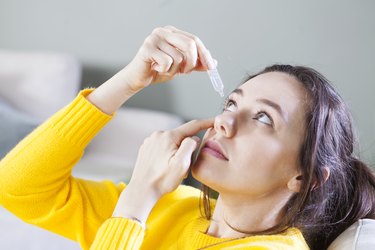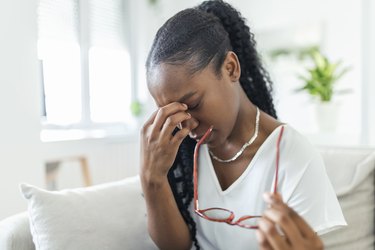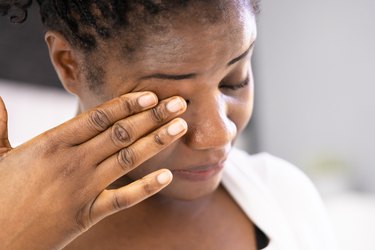
Roses, spring dresses and cupcake frosting look pretty in pink. But when the whites of your eyes turn this pastel hue, it most likely means you have pink eye — aka conjunctivitis.
Here's what causes pink eye, plus the natural home remedies that will make your peepers sparkling clear again.
Video of the Day
Video of the Day
First, What Kind of Pink Eye Do You Have?
"Conjunctivitis refers to inflammation of the conjunctiva tissue, a clear tissue that covers the white part of the eye and inside the eyelids," says Sezen Karakus, MD, assistant professor of ophthalmology at Johns Hopkins Wilmer Eye Institute. "It may be from infectious causes such as a virus or bacteria, or induced by allergens or foreign bodies such as dust."
Here's how to tell which type of pink eye is plaguing you — treatment options can vary depending on the variety you have.
- Viral: According to a May 2022 report in the National Library of Medicine, 80 percent of infectious conjunctivitis cases are viral. "Viral conjunctivitis is highly contagious yet often underdiagnosed because it resembles allergic conjunctivitis and dry eye," Dr. Karakus says. "Signs of viral pink eye include red eyes, tearing and irritation." It typically starts in one eye before spreading to the other.
- Bacterial: Bacterial pink eye is associated with a thick white, yellow or green eye discharge that might leave a crust on your lashes. It's less infectious than viral pink eye and usually only spreads with direct contact.
- Allergic: Unlike the other types of pink eye, allergic conjunctivitis is not contagious — instead, it's the result of exposure to external allergens, Dr. Karakus says. It looks identical to viral pink eye except that it also includes intense itching and the symptoms start in both eyes simultaneously.
With all that in mind, here's how to treat pink eye at home.
1. Use Artificial Tears
Lubricating eye drops help alleviate itchiness, redness and discomfort for all varieties of conjunctivitis, per a September 2020 review in the Journal of Ophthalmic & Vision Research.
"For allergic conjunctivitis, they can be used to dilute the allergens on the surface of the eye, washing them away," Dr. Karakus says. The Journal of Ophthalmic & Vision Research review also notes that artificial tears provide a barrier from allergens.
If you have bacterial or viral pink eye, your tear film (the layers coating the cornea that make up tears) is significantly disrupted, causing ouchy, itchy dry eyes. Artificial tears offer relief from this dryness.
Drop them in as needed up to four times a day until your symptoms are completely gone.
Try One of These Brands of Artificial Tears
2. Make a Cool Compress

Soothe your irritated headlights with a clean, chilled washcloth or eye mask. "This might remove some of the soreness and swelling, as well as ease itchiness," Dr. Karakus says. According to the Journal of Ophthalmic & Vision Research review, a cold compress is one of the most effective ways to feel better.
First, sterilize your H2O by boiling it and letting it cool. Then dip in a clean washcloth, squeeze it out and place it in the fridge. "Once cold, place it on top of your closed eyes for 10 minutes," Dr. Karakus says. "Alternatively, you can refrigerate an over-the-counter gel eye mask," such as this one from Comfipak ($10.99, Amazon).
3. Steer Clear of Allergens
Got allergic conjunctivitis? "The first-line treatment is to avoid whatever your eyes are sensitive to," Dr. Karakus says.
Some natural remedies for allergies include:
- If you're bothered by dust, vacuum frequently and pop dust covers on your pillows, mattress and comforter.
- For dander, just say no to hanging out with fur babies, especially in your bedroom at night.
- Keeping your windows closed will help prevent you from breathing in pollen and mold spores.
4. Apply Eye Drops With Antihistamines
Of course, unless you seal yourself off in a plastic bubble, you can't always escape allergens (for example, at certain times of year, pollen exposure is essentially unavoidable). And sometimes artificial tears aren't enough. In that case, you may want to try an antihistamine.
"Over-the-counter antihistamine eye drops address redness and itching and are very safe to use, even year-round if needed," Dr. Karakus says. The Journal of Ophthalmic & Vision Research review also confirms that anti-allergy drops ease symptoms.
We recommend Lastacaft Once Daily Eye Allergy Itch Relief Drops ($11.99, Walmart.com).
As for how often to use them, it depends on the active ingredients and their concentration, so follow the instructions on the package. Antihistamine drops are also available as a prescription.
5. Switch Off Your Screens

Digital screen use is associated with dry eye syndrome, according to a September 2021 study in Clinical Ophthalmology.
"Your eyes might need a little extra rest when you have conjunctivitis," Dr. Karakus says. "Avoid working on a computer or reading on a screen for an extended period of time if it feels uncomfortable."
Grab a paper copy of the news or a book rather than staring at your phone.
6. Try Redness-Relieving Eye Drops (With Caution!)
When you have an infection in your eye, your blood vessels expand, causing your eye to turn pink or red, according to the American Academy of Ophthalmology. Eye drops that promise to clear away redness typically contain a decongestant that temporarily constricts the blood vessels in your eye.
"Redness-relieving drops can work fast, but should not be used for more than three consecutive days or your eyes will become addicted to them," Dr. Karakus says.
She frequently sees people who struggle with persistent bloodshot eyes due to overuse of redness-relieving drops. The last thing you want is eye drops that make your pink eye even worse.
3 Ways to Clean Off Conjunctivitis Crust
Bacterial conjunctivitis is accompanied by a thick discharge that can coat your lashes. “These tips will soften the crust so you can remove it without causing further irritation,” Dr. Karakus says.
- Cook up a warm compress. Boil water and let it cool until it’s warm. (Test the temp with the inside of your wrist to make sure it’s not too hot.) Dip a clean washcloth in the water and wring out the excess. Place over your shut eye for 10 minutes. Good to know: Only apply a warm compress if your eye is not swollen — the heat can exacerbate inflammation.
- Wash your lashes with baby shampoo that’s gentle on your eyes.
- Douse a cotton ball with eyelid cleanser (available at drugstores) and swipe it across your lashes.
7 Tips to Prevent Spreading Pink Eye
Not only can you pass viral and bacterial pink eye to other people, but if you're not cautious, you can infect your other eye — or get reinfected after the initial infection has resolved.
Here's how to put the brakes on transmission, per Dr. Karakus:
- Keep your hands clean: Wash your hands frequently for 20 seconds and squirt on hand sanitizer. Avoid touching your eyes.
- Grab some Lysol: Clean high-touch surfaces daily. Germ hot spots include faucets, light switches, cabinet and drawer pulls, doorknobs, countertops and stair railings.
- Throw out used tissues: Viral pink eye is associated with intense tearing. Don't reuse tissues you've dabbed your eye with or leave dirty tissues on the counter. Post-tissue use, don't touch shared surfaces until you've washed your hands.
- Reach for a paper towel: After washing your face, blot your skin dry with a disposable paper towel that you can toss instead of a cloth towel.
- Change your pillowcase every day: Wash it in hot water. You should also frequently launder sheets and towels in hot H2O.
- Throw out your eye makeup: The safest practice is to get new eye and face products. If you can't bear to trash it all, then at least quarantine your cosmetics for two weeks. (Fingers crossed the virus will be gone by then!) You can wash brushes thoroughly with soap and hot water.
- Stop using contacts: After the infection has cleared, replace them with brand-new contacts as well as getting a new case and bottle of contact lens solution.
FAQs
1. What Are the Main Causes of Pink Eye?
If you're thinking, "How did I get pink eye overnight?" it may be helpful to understand the main causes of the infection. "Viral or bacterial pink eye is usually from touching a contaminated surface and afterward touching your eye with unclean hands," Dr. Karakus says.
For example, let's say you share a towel with someone who's either got conjunctivitis or is carrying the microorganisms that cause it. Bam: The pink fairy may be headed your way.
Or perhaps someone with conjunctivitis touches a doorknob. If you place your hand on the same knob and then rub your eye or, even worse, put in contact lenses without washing your hands first? The next morning, you might wake up a red, itchy mess.
Allergic conjunctivitis is triggered by environmental allergies. Dust allergies can get worse overnight because dust mites settle into your bedding. If you have pollen or mold allergies and sleep next to an open window, your peepers might be pink in the a.m.
2. How Long Is Pink Eye Contagious For?
It depends on the strain of virus or bacteria that caused it.
"Most viruses are contagious for one week, though some can be contagious for up to two weeks," Dr. Karakus says. "While symptoms usually subside in three to four days, be careful for a full week because there is a chance you may continue to spread infection."
Bacterial pink eye doesn't transmit as easily, typically requiring direct contact. Still, follow the same precautions. Allergic pink eye is not contagious.
3. Can Pink Eye Clear Up on Its Own?
Yes! It is a self-limiting infection, meaning it will resolve sans medicine.
"Prescription drops can help reduce duration of the infection, but it's typically not necessary," Dr. Karakus says. "If it has been a few days and it's not getting better — or if you have significant vision changes beyond a little blurriness — then you might want to see an eye care specialist."
4. What Should You Do if Your Child Has Pink Eye?
Pink eye in children it is usually accompanied by an upper respiratory tract infection, including fever and a runny nose. In most cases, home treatment with cold compresses should suffice. Feel free to try artificial tears, too.
But keep, ahem, an eye on things: "If the eye is very swollen and red or your child is in a great deal of discomfort, you should see a pediatrician, and if necessary, an eye care specialist," Dr. Karakus says. "If symptoms are getting worse rather than better after a day or two, this also warrants a call to the doctor."
With children, it's more difficult to control the spread of pink eye. "Don't send your child to school until the contagious period is over," Dr. Karakus says.
5. What Else Can Cause Red-Tinted Eyes?
While pink eye is the obvious cause for reddened eyes, it's not always the right diagnosis. "Severe eye pain, decreasing vision or increasing swelling and redness might indicate another condition," Dr. Karakus says.
For instance, if you use contacts and see a white or gray spot on your cornea accompanied by extreme eye discomfort, you might have a cornea infection. A stye could also be to blame: It can cause redness, eye tenderness and vision changes.
- Clinical Ophthalmology: "The Relationship Between Dry Eye Disease and Digital Screen Use"
- American Academy of Ophthalmology: "Redness-Relieving Eye Drops"
- Journal of Ophthalmic & Vision Research: "Conjunctivitis: A Systematic Review"
- National Eye Institute: "Pink Eye"
- National Library of Medicine: "Conjunctivitis"
Is this an emergency? If you are experiencing serious medical symptoms, please see the National Library of Medicine’s list of signs you need emergency medical attention or call 911.


